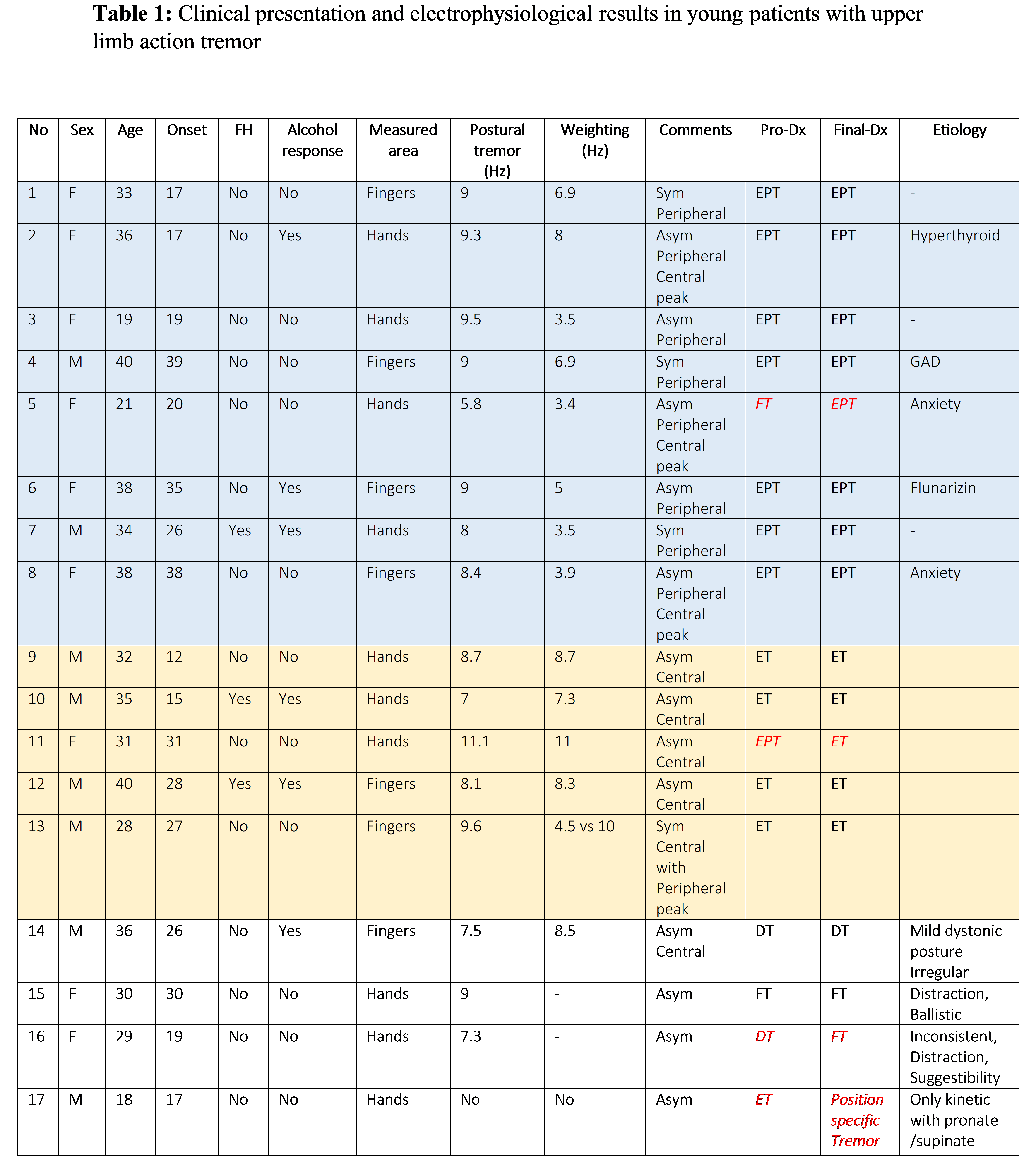Category: Tremor
Objective: To explore the role of neurophysiological testing in young adult patients with bilateral upper limb action tremor.
Background: Essential tremor (ET) and enhance physiologic tremor (EPT) are the two most common disorders involving bilateral upper limb action tremor in young adults. Clinically, it is difficult to distinguish between EPT and mild ET. Bedside neurophysiological testing may be helpful in the differential diagnosis of these two disorders. (1,2,3)
Method: 17 patients (8 men, 9 women; age, 18-40 years; age of tremor onset, 12-39 years) who presented with bilateral action tremor of the hands were recruited. Provisional diagnosis was made for each patient and neurophysiological testing was performed according to the initial indication. Measurement of hand or finger tremor was conducted using (1) an accelerometer placed on the dorsal surface of the hands or fingers and (2) surface EMG applied on the flexor and extensor muscles. Tremors were recorded during posture, posture with loading and during kinetic action. The dominant frequency peak of tremor (Hz) and EMG patterns were analyzed.
Results: In our study, the most frequent tremor syndrome was EPT (8/17; 47.1%), followed by ET (5/17, 29.4%), functional tremor (2/17, 11.7%), dystonic tremor (1/17, 5.9% with mild hand dystonia and irregular tremor) and position specific tremor (1/17, 5.9%) [table1]. This provisional diagnosis was confirmed by the neurophysiological tests in 76% of cases. The mean peak postural tremor frequency of EPT was 8.5 ± 1.1 Hz. A shift of tremor frequency more than 1 Hz with loading was noted in all patients with EPT. 3 of 8 patients (37.5%) in EPT group showed a 6-12 Hz central peak. The aetiologies of EPT included thyroid disorders, drug induced and anxiety. All ET patients had a central component with no frequency shift with loading. Inconsistency of tremor frequency, distractibility and suggestibility were revealed in two patients with functional tremor. Tremor in one patient was demonstrated only during kinetic actions involving pronation and supination of the arm, but not during posture, consistent with a position specific tremor.
Conclusion: In our cohort, EPT is more common than ET in young patients with bilateral upper limb action tremor. We demonstrated a role for neurophysiological testing to aid the differential diagnosis of common tremor syndromes.
References: 1. Crawford, P. and E. E. Zimmerman (2011). “Differentiation and diagnosis of tremor.” Am Fam Physician 83(6): 697-702; 2. Gironell A, Kulisevsky J, Pascual-Sedano B, Barbanoj M. Routine neurophysiologic tremor analysis as a diagnostic tool for essential tremor: a prospective study. J Clin Neurophysiol. 2004;21(6):446-50; 3. Van der Stouwe, A. M., et al. (2016). “How typical are ‘typical’ tremor characteristics? Sensitivity and specificity of five tremor phenomena.” Parkinsonism Relat Disord 30: 23-28.
To cite this abstract in AMA style:
T. Dang, P. Panyakaew, R. Bhidayasiri. Can bedside neurophysiological testing aid the differential diagnosis of bilateral upper limb action tremors in young-onset patients? [abstract]. Mov Disord. 2020; 35 (suppl 1). https://www.mdsabstracts.org/abstract/can-bedside-neurophysiological-testing-aid-the-differential-diagnosis-of-bilateral-upper-limb-action-tremors-in-young-onset-patients/. Accessed April 21, 2025.« Back to MDS Virtual Congress 2020
MDS Abstracts - https://www.mdsabstracts.org/abstract/can-bedside-neurophysiological-testing-aid-the-differential-diagnosis-of-bilateral-upper-limb-action-tremors-in-young-onset-patients/

